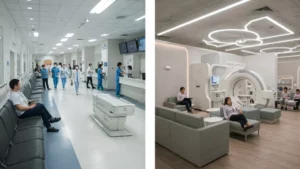A brain aneurysm is a severe medical ailment requiring serious treatment to prevent a potentially life-threatening condition.
Also known as cerebral aneurysms, this disease is considered a silent killer as it shows the slightest symptoms until it ruptures.
The Brain Aneurysm Foundation says that over 30 000 Americans suffer from ruptured brain aneurysms yearly. About 40 percent of those cases lead to death within 24 hours.
Brain aneurysms are not easily preventable. It can strike anyone at any age. However, you can lower your risk of developing this silent killer if you get early detection.
This article discusses how to diagnose a brain aneurysm and the preventive measures you can adopt to start living a life away from this dreadful condition.
What Is a Brain Aneurysm?
A brain aneurysm is a tiny and weak bulge in your brain’s blood vessels.
Like a berry dangling on a stem, a cerebral aneurysm can be dangerous if it leaks or ruptures, causing a hemorrhagic stroke. Immediate medical treatment is needed to prevent the aneurysm from being fatal.
While an aneurysm can rupture, other brain aneurysms do not. Detection of an aneurysm is the best way to prevent a rupture or complication.
Types of Brain Aneurysm
Brain aneurysms come in different forms and can be located in other brain parts.
Saccular aneurysm
A rounded sac filled with blood, this aneurysm is attached to the main artery and looks like a berry. This common type of aneurysm is found on the base of the brain and is common among adults.
Fusiform aneurysm
This type of aneurysm bulges out on all the sides of the blood vessel’s walls.
Mycotic aneurysm
An aneurysm stems from an infection in the brain and affects the arteries.
Brain Aneurysm Symptoms
Are there any warning signs of a brain aneurysm?
In most cases, the condition will not show what a brain aneurysm feels like until it ruptures.
You have to seek immediate medication as soon as these symptoms occur:
- Sudden severe headache
- Loss of consciousness
- Drowsiness
- Loss of balance
- Nausea and vomiting
- Blurred vision
- Stiff neck
- Seizure
- Drooping eyelid
- Dilated pupils
On the other hand, an unruptured brain aneurysm may still show slight symptoms as it grows bigger and presses against nerves and tissues.
Some of the symptoms of an unruptured brain aneurysm are:
- Loss of vision or visual disturbances
- Pain around the eye
- Weakness on one side of the dace
- Headache
- Difficulty in speaking
- Loss of concentration
- Short-term memory
- Loss of balance
If any of these symptoms have been occurring, go to One Step Diagnostic and take the most appropriate imaging tests your doctor may require. Call us today to book an appointment.
Brain Aneurysm Causes
There is no specific evidence on the actual cause of brain aneurysms.
However, experts link the disease to these factors:
- Age. Brain aneurysm is more common among people over 40 and older.
- Gender. Women have higher rates of brain aneurysms compared to men.
- Medical history. People with hypertension, atherosclerosis, and traumatic brain injury are at risk of developing a brain aneurysm.
- Drug dependency. Users of illegal drugs such as amphetamine and cocaine are more prone to brain aneurysms.
- Lifestyle habits. Smokers have a higher risk of the disease due to the nicotine that thickens the walls of blood vessels.
What Causes Brain Aneurysms to Rupture?
Various factors can trigger a ruptured brain aneurysm.
These are the common reasons why brain aneurysm rupture:
- High blood pressure. High blood pressure increases pressure and force on the walls of your brain’s arteries.
- Heavy lifting. Intensive exertion of force puts pressure on the brain, causing the aneurysm to rupture.
- Intense emotions. High levels of emotions, such as anger, can trigger high blood pressure, which may cause rupture aneurysms.
- Illegal drugs. Substances such as cocaine can inflame the wall of the blood vessels.
Brain Aneurysm Risk Factors
Brain aneurysms can happen to anyone. But there is a specific population who are at risk of this disease.
Medical history
Your medical history can predict a possible brain aneurysm. You must consult your doctor regularly to monitor any trigger for a brain aneurysm.
- High blood pressure
- Head injury or trauma
- Cancer
- Infection
- Abnormalities at birth, such as cerebral arteriovenous malformation
- Atherosclerosis or fat build-up on arteries’ interior walls
- Family history of a brain aneurysm
Lifestyle
Your lifestyle choice is integral in shaping your risk for a brain aneurysm. Smoking, excessive alcohol consumption, and drug abuse put you in danger of cardiovascular diseases and brain damage.
Brain Aneurysms in Children
Children can have a brain aneurysm, but this is a rare scenario. Boys are more likely to have the disease. Brain aneurysms among children 18 years or older may be linked to medical conditions such as head trauma, infection, genetic disorders, and connective tissue disorders.
Brain Aneurysm Diagnosis
The presence of brain aneurysm symptoms warrants immediate medical action.
How do you know if you have a brain aneurysm? You must consult a doctor once you experience any warning signs of an aneurysm so you can be diagnosed early.
Undergoing diagnostic tests is essential in preventing more life-threatening risks from this disease.
Computerized Tomography (CT).
A specialized X-ray test identifies any brain bleeding or abnormal occurrences such as stroke. A CT scan captures 2D images of the brain in slices.
Cerebrospinal Fluid Test
When a CT scan doesn’t show images of bleeding yet you have severe symptoms of a ruptured aneurysm, your doctor may require the cerebrospinal fluid test that indicates the presence of red blood cells in your brain and spine.
Magnetic Resonance Imaging (MRI)
An imaging examination involves a magnetic field and radio waves to capture brain images in 2D and 3D images.
Cerebral Angiogram
A procedure that uses a thin tube with a special dye that travels throughout the brain once inserted in a large artery. The X-ray images will show locate the aneurysm and check on the condition of your arteries.
Brain Aneurysm Treatment
A rupture brain aneurysm requires immediate treatment because it can pose a dangerous threat to your health. The goal is to stop blood flow into the aneurysm through any of these treatments.
Surgical clipping
A procedure that removes a section of your skull to find the aneurysm and cut off its opening using a metal clip to prevent blood flow.
Endovascular coiling
A procedure that inserts a catheter into the groin and locates the blood vessel where the aneurysm is found. Your doctor will put tiny platinum coils inside the aneurysm, which helps in ceasing the blood flow. Although this does not require opening the skull, it has higher risks of rebleeding.
Flow diverter surgery
A procedure that uses a stent made of metal mesh and placed inside the artery. It serves as a wall that pushes blood away from the aneurysm. This method is a standard option for a larger brain aneurysm.
These procedures are risky and require a crucial assessment of your condition. Your healthcare provider shall weigh the size and location of your aneurysm to come up with the best treatment method.
Brain Aneurysm Complications
Once your brain aneurysm ruptures, it can lead to a severe and life-threatening condition.
Some of the complications that come with a ruptured brain aneurysm include:
- Cerebral vasospasm. A reduced blood flow to the brain.
- Hydrocephalus. Build up of too much spinal fluid in the cavities of the brain.
- Coma. A state of unconsciousness and unresponsiveness.
- Brain damage. Permanent damage and deterioration of brain cells.
- Hyponatremia. Low sodium in the blood may lead to seizures and coma.
Brain Aneurysm Prevention
The risk of having a brain aneurysm is avoidable. You can avoid this dreaded illness by eating a balanced diet, physical activity, and lifestyle changes.
If you are already diagnosed with an aneurysm, you can still take preventative measures to lower the risk of it growing or leaking.
Here are preventive measures to consider:
- Stop smoking. Over 60 percent of people who sustained aneurysms are smokers. Additionally, tobacco use is one of the leading causes of other diseases, such as cardiovascular disease and diabetes. Smoking is generally a primary factor for any condition.
- Eat a balanced diet. Choose a low-fat and free-free diet and avoid high in sugar food to lower your danger of cardiovascular disease, which contributes to the risk of a brain aneurysm.
- Maintain an active lifestyle. Obtain the recommended weight for your gender and age and engage yourself in physical activities., Choose activities that do not require strong forces, such as heavy lifting.
- Take maintenance medicines. If you have high blood pressure, keep it under control with maintenance medicines. Be disciplined, and don’t skip regular medicine intake.
How to Diagnose Brain Aneurysm
If you are experiencing slight blurry visions or headache brain aneurysm symptoms, the best move to make is to consult your physician. Your specialist will require you to undergo different examinations which can diagnose if you have the condition or not.
One Step Diagnostic provides a wide array of diagnostic services that helps in the early detection of life-threatening conditions, including brain aneurysm.
We are the leading facility for CT scans and MRI scans which are both vital on how to diagnose brain aneurysm.
Get started with early brain aneurysm detection today! Call us to book an appointment at our locations in Houston, Sugar Land, Dickinson, and The Woodlands, TX.




